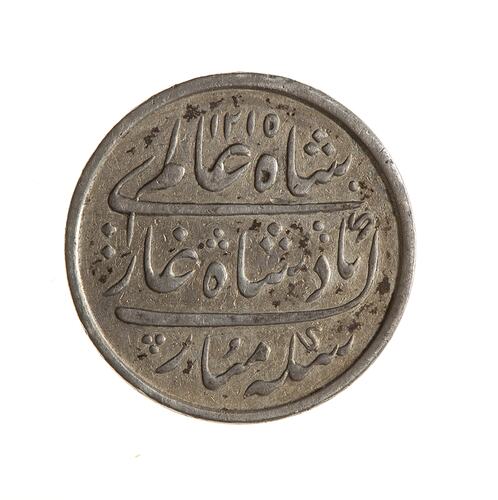Summary
1/4 Rupee, Issued by Bombay Presidency, India, 1832-1835
In the name of Shah Alam
Minted by Bombay Mint (although named as Surat)
Note:The complete impression of the dies on the coins
Obverse Description
Legend in Persian script, (legend translation: The auspicious coin of the Victorious Emperor Shah Alam, 1215)
Reverse Description
Julus formula legend in Persian script, (legend translation: Struck at Surat in the 46th year of his reign of tranquil prosperity), centre of coin damaged by old mount
Edge Description
Plain
Significance
A new mint, fitted out with up-to-date minting machinery, was opened at Bombay in 1831 (the old mint being closed on 28 April 1831). The new mint continued the production of coins in the old style until new dies were ready in July 1832. The type is copied from the Bombay Surat rupee but now shows the entire design on all coins. It contains a number of anomalies: the mint name is given as Surat although that mint was closed in 1815; the the AH date 1215 commenced on 25 May 1800; the 46th julus year commenced 29 July 1803 and the Emperor Shah Alam died in 1806. The coins were struck between 1832 and 1834 with the 'frozen' names and dates being employed for commercial reasons - to stop money-changers dropping the value of old coins when new ones were issued. Similar coins to this were struck at Calcutta in 1824-1825, the Calcutta coins had edge milling. This issue was replaced by the East-India Company standard rupee for India in 1835 but remained legal tender until 1 June 1878.
More Information
-
Collecting Areas
-
Acquisition Information
Transfer from Melbourne Branch of Royal Mint, 1978
-
Date Issued
1832-1835 AD
-
Issued By
-
Mint
-
Denomination
-
Series
-
Material
Silver
-
Axis
06
-
Classification
-
Category
-
Discipline
-
Type of item
-
Dimensions
17.5 mm (Outside Diameter), 2.91 g (Weight)
-
Shape
Round
-
References
Pridmore 290 KM#222
[Book] Pridmore, Fred. 1975. The Coins of the British Commonwealth of Nations, Part 4, India. 1.
[Book] Bruce, Colin R. 2006. Standard Catalogue of World Coins 1801 - 1900., 696 Pages
-
Keywords
British Commonwealth Coins, British Commonwealth and Empire Coins











